产品中心
当前位置:首页>产品中心Anti-SIRT1
货号: bs-0921R 基本售价: 380.0 元 规格: 20ul
- 规格:20ul
- 价格:380.00元
- 规格:50ul
- 价格:780.00元
- 规格:100ul
- 价格:1380.00元
- 规格:200ul
- 价格:2200.00元
产品信息
- 产品编号
- bs-0921R
- 英文名称
- SIRT1
- 中文名称
- 沉默调节蛋白1抗体
- 别 名
- 75SirT1; BA57G10.4; hSIR2; hSIRT1; NAD dependent deacetylase SIRT1; NAD dependent deacetylase sirtuin 1; NAD dependent deacetylase sirtuin 2; Silent mating type information regulation 2; OTTHUMP00000198111; OTTHUMP00000198112; SIR2 like 1; SIR2 like protein 1; SIR2-like protein 1; Regulatory protein SIR2 homolog 1; SIR1_HUMAN; SIR2ALPHA; SIR2alpha protein; SIR2L1; SIR2L2; SIRT 1; SIRT-1; Sirt1; SIRT1 Sir2 like proteins (siruitins) type 1; SIRT1: sirtuin (silent mating type information regulation 2 homolog) 1 (S. cerevisiae); sirtuin (silent mating type information regulation 2 homolog) 1 (S. cerevisiae); SirtT1 75 kDa fragment; sirtuin (silent mating type information regulation 2 homolog) 1 (S. cerevisiae);Sirtuin 1; sirtuin; Sirtuin type 1; Sirtuin type 2.

- Specific References (3) | bs-0921R has been referenced in 3 publications.[IF=5.36] Mohan, Mahesh, et al. "Dysregulated miR34a SIRT1 Acetyl p65 Axis Is a Potential Mediator of Immune Activation in the Colon during Chronic Simian Immunodeficiency Virus Infection of Rhesus Macaques." The Journal of Immunology (2014): 1401447.PubMed:25452565[IF=3.10] Yan, Dongying, et al. "Effects of Aluminium on long‐term Memory in Rats and on SIRT1 Mediating the Transcription of CREB‐Dependent Gene in Hippocampus." Basic & Clinical Pharmacology & Toxicology (2017). WB ; Rat.PubMed:28429887[IF=3.74] Hu, Zheng, et al. "5-Aminolevulinic acid-mediated sonodynamic therapy induces anti-tumor effects in malignant melanoma via p53-miR-34a-Sirt1 axis." Journal of dermatological science 79.2 (2015): 155-162. WB ; Mouse.PubMed:25982144
- 规格价格
- 50ul/780元购买 100ul/1380元购买 200ul/2200元购买 大包装/询价
- 说 明 书
- 50ul 100ul 200ul
- 研究领域
- 细胞生物 免疫学 染色质和核信号 微生物学 新陈代谢 表观遗传学
- 抗体来源
- Rabbit
- 克隆类型
- Polyclonal
- 交叉反应
- Human, Mouse, Rat, Chicken, Cow, Horse, Rabbit,
- 产品应用
- WB=1:500-2000 ELISA=1:500-1000 IHC-P=1:400-800 IHC-F=1:400-800 Flow-Cyt=1μg/Test IF=1:100-500 (石蜡切片需做抗原修复)
not yet tested in other applications.
optimal dilutions/concentrations should be determined by the end user.
- 分 子 量
- 58/81kDa
- 细胞定位
- 细胞核 细胞浆
- 性 状
- Lyophilized or Liquid
- 浓 度
- 1mg/ml
- 免 疫 原
- KLH conjugated synthetic peptide derived from human SirtT1:101-200/747
- 亚 型
- IgG
- 纯化方法
- affinity purified by Protein A
- 储 存 液
- 0.01M TBS(pH7.4) with 1% BSA, 0.03% Proclin300 and 50% Glycerol.
- 保存条件
- Store at -20 °C for one year. Avoid repeated freeze/thaw cycles. The lyophilized antibody is stable at room temperature for at least one month and for greater than a year when kept at -20°C. When reconstituted in sterile pH 7.4 0.01M PBS or diluent of antibody the antibody is stable for at least two weeks at 2-4 °C.
- PubMed
- PubMed
- 产品介绍
- background:
This gene encodes a member of the sirtuin family of proteins, homologs to the yeast Sir2 protein. Members of the sirtuin family are characterized by a sirtuin core domain and grouped into four classes. The functions of human sirtuins have not yet been determined; however, yeast sirtuin proteins are known to regulate epigenetic gene silencing and suppress recombination of rDNA. Studies suggest that the human sirtuins may function as intracellular regulatory proteins with mono-ADP-ribosyltransferase activity. The protein encoded by this gene is included in class I of the sirtuin family. Alternative splicing results in multiple transcript variants.
Function:
NAD-dependent protein deacetylase, which regulates processes such as apoptosis and muscle differentiation by deacetylating key proteins. Deacetylates Lys-382 of p53/TP53 and impairs its ability to induce proapoptotic program and modulate cell senescence. Deacetylates TAF1B and thereby represses rDNA transcription by the RNA polymerase I. Deacetylates Lys-266 of SUV39H1, leading to its activation. Deacetylates Lys-26 of HIST1H1E. Involved in HES1- and HEY2-mediated transcriptional repression. Inhibits skeletal muscle differentiation by deacetylating PCAF and MYOD1. May serve as a sensor of the cytosolic ratio of NAD(+)/NADH, which is essential in skeletal muscle cell differentiation. Deacetylates Lys-16 of histone H4 (in vitro). Component of the eNoSC (energy-dependent nucleolar silencing) complex, a complex that mediates silencing of rDNA in response to intracellular energy status and acts by recruiting histone-modifying enzymes. The eNoSC complex is able to sense the energy status of cell: upon glucose starvation, elevation of NAD(+)/NADP(+) ratio activates SIRT1, leading to histone H3 deacetylation followed by dimethylation of H3 at Lys-9 (H3K9me2) by SUV39H1 and the formation of silent chromatin in the rDNA locus. Deacetylates H2A. In case of HIV-1 infection, interacts with and deacetylates the viral Tat protein. Deacetylates APEX1 at Lys-6 and Lys-7. Stimulates cellular AP endonuclease activity by promoting the association of APEX1 to XRCC1.
Subunit:
Found in a complex with PCAF and MYOD1. Component of the eNoSC complex, composed of SIRT1, SUV39H1 and RRP8. Interacts with HES1, HEY2 and PML. Interacts with RPS19BP1/AROS. Interacts with KIAA1967/DBC1 (via N-terminus); the interaction disrupts the interaction between SIRT1 and p53/TP53. Interacts with SETD7; the interaction induces the dissociation of SIRT1 from p53/TP53 and increases p53/TP53 activity. Interacts with MYCN, NR1I2, CREBZF, TSC2, TLE1, FOS, JUN, NR0B2, PPARG, NCOR, IRS1, IRS2 and NMNAT1. Interacts with HNF1A; the interaction occurs under nutrient restriction. Interacts with SUZ12; the interaction mediates the association with the PRC4 histone methylation complex which is specific as an association with PCR2 and PCR3 complex variants is not found. Interacts with HIV-1 tat.
Subcellular Location:
Nucleus, PML body. Cytoplasm. Note=Recruited to the nuclear bodies via its interaction with PML. Colocalized with APEX1 in the nucleus. May be found in nucleolus, nuclear euchromatin, heterochromatin and inner membrane. Shuttles between nucleus and cytoplasm.
SirtT1 75 kDa fragment: Cytoplasm. Mitochondrion.
Tissue Specificity:
Widely expressed.
Post-translational modifications:
Methylated on multiple lysine residues; methylation is enhanced after DNA damage and is dispensable for deacetylase activity toward p53/TP53.
Phosphorylated. Phosphorylated by STK4/MST1, resulting in inhibition of SIRT1-mediated p53/TP53 deacetylation. Phosphorylation by MAPK8/JNK1 at Ser-27, Ser-47, and Thr-530 leads to increased nuclear localization and enzymatic activity.
Phosphorylation at Thr-530 by DYRK1A and DYRK3 activates deacetylase activity and promotes cell survival. Phosphorylation by mammalian target of rapamycin complex 1 (mTORC1) at Ser-47 inhibits deacetylation activity. Phosphorylated by CaMK2, leading to increased p53/TP53 and NF-kappa-B p65/RELA deacetylation activity (By similarity). Phosphorylation at Ser-27 implicating MAPK9 is linked to protein stability. There is some ambiguity for some phosphosites: Ser-159/Ser-162 and Thr-544/Ser-545.Proteolytically cleaved by cathepsin B upon TNF-alpha treatment to yield catalytic inactive but stable SirtT1 75 kDa fragment (75SirT1).
S-nitrosylated by GAPDH, leading to inhibit the NAD-dependent protein deacetylase activity.
Similarity:
Belongs to the sirtuin family.
Contains 1 deacetylase sirtuin-type domain.
SWISS:
Q96EB6
Gene ID:
23411
Database links:Entrez Gene: 23411 Human
Entrez Gene: 93759 Mouse
Entrez Gene: 309757 Rat
Omim: 604479 Human
SwissProt: Q96EB6 Human
SwissProt: Q923E4 Mouse
Unigene: 369779 Human
Unigene: 351459 Mouse
Important Note:
This product as supplied is intended for research use only, not for use in human, therapeutic or diagnostic applications.
在Sirtuin蛋白家族中,sirtuin 1(沉默信息调节子)参与多种新陈代谢活动,包括DNA的自我保护和修复,抑制脂质过氧化积累,抑制其他细胞凋亡相关基因的表达以及和细胞寿命相关的活动。限制摄入的热量可以加强SIRT1的表达,从而延长了寿命。
SIRT蛋白成为多种生物过程的调节者也参与衰老的调控。在研究最多的SIRT蛋白中,SIRT1与各种非组蛋白或者转录因子相互作用,包括p53、FOXO蛋白、p300、NFkB和MyoD,sirtuins可参与凋亡、细胞存活、转录和代谢等过程。以sirtuins为靶标的药物可能在治疗衰老、癌症、糖尿病和神经退行性变中有用。
- 产品图片
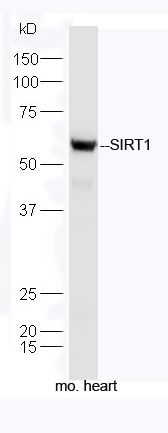 Sample:Heart (Mouse) Lysate at 30 ug
Sample:Heart (Mouse) Lysate at 30 ug
Primary: Anti-SIRT1 (bs-0921R) at 1:300 dilution;
Secondary: HRP conjugated Goat-Anti-rabbit IgG(bs-0295G-HRP) at 1: 5000 dilution;
Predicted band size: 58/81 kD
Observed band size: 58 kD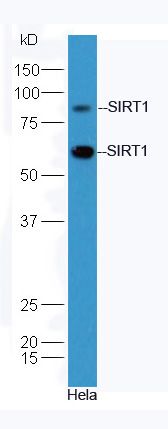 Sample:Hela Cell Lysate at 30 ug
Sample:Hela Cell Lysate at 30 ug
Primary: Anti-SIRT1 (bs-0921R) at 1:500 dilution;
Secondary: HRP conjugated Goat-Anti-rabbit IgG(bs-0295G-HRP) at 1: 5000 dilution;
Predicted band size: 58/81 kD
Observed band size: 58/81 kD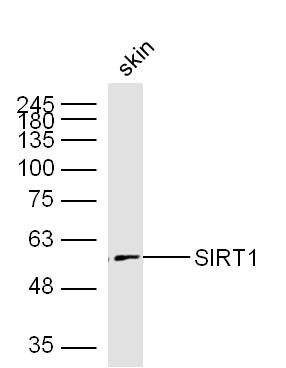 Sample:Skin (Mouse) Lysate at 30 ug
Sample:Skin (Mouse) Lysate at 30 ug
Primary: Anti-SIRT1 (bs-0921R) at 1/300 dilution
Secondary: IRDye800CW Goat Anti-Mouse IgG at 1/20000 dilution
Predicted band size: 58/81 kD
Observed band size: 58 kD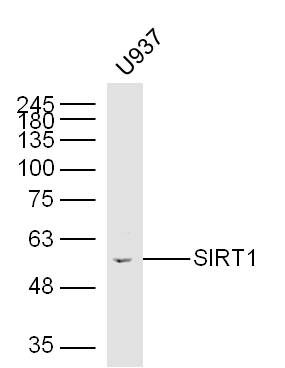 Sample:U937 Cell Lysate at 30 ug
Sample:U937 Cell Lysate at 30 ug
Primary: Anti-SIRT1 (bs-0921R) at 1/300 dilution
Secondary: IRDye800CW Goat Anti-Mouse IgG at 1/20000 dilution
Predicted band size: 58/81 kD
Observed band size: 58 kD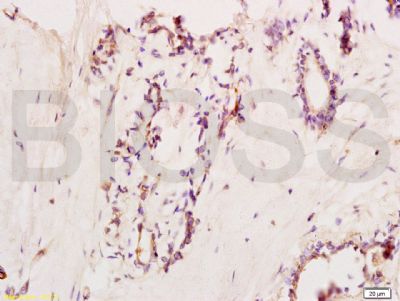 Tissue/cell: human endometrium carcinoma; 4% Paraformaldehyde-fixed and paraffin-embedded;
Tissue/cell: human endometrium carcinoma; 4% Paraformaldehyde-fixed and paraffin-embedded;
Antigen retrieval: citrate buffer ( 0.01M, pH 6.0 ), Boiling bathing for 15min; Block endogenous peroxidase by 3% Hydrogen peroxide for 30min; Blocking buffer (normal goat serum,C-0005) at 37℃ for 20 min;
Incubation: Anti-SIRT1 Polyclonal Antibody, Unconjugated(bs-0921R) 1:200, overnight at 4°C, followed by conjugation to the secondary antibody(SP-0023) and DAB(C-0010) staining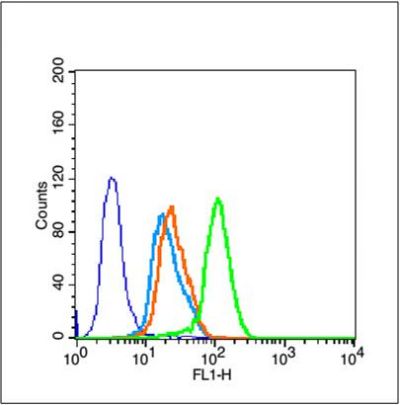 Blank control (blue line): MCF 7 (blue).
Blank control (blue line): MCF 7 (blue).
Primary Antibody (green line): Rabbit Anti-SIRT1 antibody (bs-0921R)
Dilution: 3μg /10^5 cells;
Isotype Control Antibody (orange line): Rabbit IgG .
Secondary Antibody (white blue line): Goat anti-rabbit IgG-FITC
Dilution: 1μg /test.
Protocol
The cells were fixed with 70% methanol (Overnight at 4℃) and then permeabilized with 90% ice-cold methanol for 30 min on ice. Cells stained with Primary Antibody for 30 min at room temperature. The cells were then incubated in 1 X PBS/2%BSA/10% goat serum to block non-specific protein-protein interactions followed by the antibody for 15 min at room temperature. The secondary antibody used for 40 min at room temperature. Acquisition of 20,000 events was performed.

